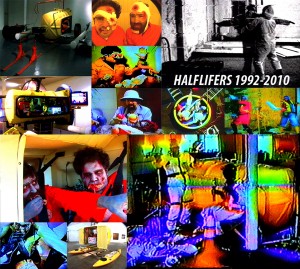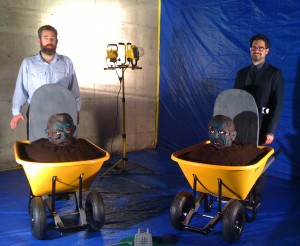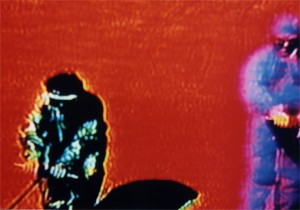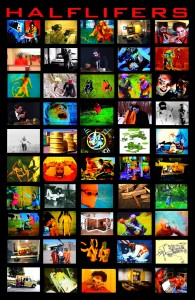Issue 28 11.20.13

HALFLIFERS
2012 Questions for HALFLIFERS
by George Pfau
As a collaborative team of two, how did the HalfLifers merge their notions of the zombie into a singular package?
HalfLifers as a project has always emerged out of a space of shared interests and dialogue…we’d always both had an interest in the idea of the zombie (based mostly on its figure in cinematic space) and at some point in our continually evolving conversations it re-emerged in the context of HalfLifers. We had talked about doing something with zombies where the undead characters illicit a feeling of sadness and or alternating inspiration by continually exploring there decaying bodies and environment. We both have an interest in humor and strategies with breaking the 4th wall. Also we were excited to investigate improvisational and gestural movements, always pushing the unliving characters from slapstick to more intense “splatstick” scenes. This might have been us picking up on a certain note of physical humor that manifests in the later Romero and especially the Dan O’Bannon films. And since so much of HalfLifers work up to that point was based on ideas about injury & crisis, I think we sort of arrived at this idea of being undead as kind of the ultimate “injured” state.
The Halflifers video shooting strategy allows for endless accumulation of materials or “takes”. Often we find common threads, motivations, and inspirations by not having any time constraints put on us. We literally video tape everything including the meta-discussions on what we are actually trying to do at any given moment…often this material is the most interesting and becomes reworked or restaged even at the same moment of discovery.….In the case of our ongoing Zombie series Afterlifers, incarnations of our Jim & Joe doubles returned from a non-linear death. This (zombie-zone) not only has moving entities but also has patches or geographies of “unliving” and “undead” spaces. We also engaged various props, costumes and vehicle elements that were zombified including sections of a flying helicopter, drinking dead booze, and re-animating analog phone devices from previous video work.
Were there certain seminal zombie films/texts/videogames that really got your creative juices flowing?
Several pieces that we enjoyed actively explored a fusion of horror (superstitions), comedy (slapstick), and art genres (choreography). They include Lucio Fulci’s “Zombi 2”, Dan O’Bannon’s “The Return of the Living Dead”, John Landis + Michael Jackson’s “Thriller”, and all of the George Romero films.
Your mentioning of “The Return of the Living Dead” makes me think of your 2011 installation at the Berkeley Art Museum, in which visitors (myself included) got to eat cake versions of the Halflifers’ zombified heads. That film was the first of the zombie genre in which the undead have a voracious hunger for brains. It seems like your piece reverses this idea, allowing the living to consume the undead brain. Can you discuss this installation, and how it came about?
We had been asked to do something for Berkeley’s L@TE series, which are one-night events. There wasn’t time or a budget to do any of the large-scale, sculptural installations we had done at points in the past, and we were trying to think of how to still do something that felt sculptural but would function better in the context of a short hybrid performance event. Somehow we arrived at the idea of having these life-size cake replicas of ourselves that would get wheeled out and consumed. We then went through a lot of discussions about how these would arrive and what they’d look like. Gradually it got scaled down to a pair of heads, but we realized that we’d really wanted the cakes to function sculpturally as vehicles. After a lot of back and forth, we finally arrived at these sort of “Gravicle Scout Craft,” which were micro-graves housed in wheelbarrow “ships” with zombie version of our own heads sticking up out of the grave, as though they were piloting these crafts. Later in the evening we got to slice open our undead doubled chocolate and butter cream fondant wrapped heads, and serve a voracious public who seemed very happy to eat our sweet simulated brains.
In both cases we’re just sort of bending our own language around…obviously AfterLifers was a play on HalfLifers. We came up with the name HalfLifers back in 1994; it was actually based on the name of the alternate reality the dead characters in Philip K. Dick’s “Ubik” experience while in cryogenic suspension. This idea of a kind of phantom reality that you experienced when you were essentially dead, but not completely dead, was a key reference point for us. Ubik was the first PKD book each of us had read, and it had always remained one of our favorites. In AfterLifers, we came back to this idea of undead-ness (or unliving-ness) as a space, rather than merely a condition of the body–we talked about Zombie Space as a different phase of reality in which everything manifests in a decaying, compromised state.
It seems that zombie narratives are overwhelmingly about the zombie threat to humanity. While Afterlifers contains some flesh chewing, there are no real acts of violence in the film. How did you arrive at this less hostile depiction of the zombie?
We were never interested in the zombie as a threat or object of dread–it was much more about the pathos of the zombie, and an inquiry into what else zombies would do with themselves when there were no living humans to pursue. The idea of zombie just wandering around, trying to figure out what to do with themselves, was really interesting to us. Instead of violent acts there is a focus on empathic exchanges between the two transitory characters and their decaying circumstances. In the videotapes we see moments of extreme confusion, fear and hunger. But over and over again they would rather eat their own bodies than engage in a violent act. One of the most “violent” scenes is towards the end of the videotape and we see the Afterlifers at their table, conversation has broken down and they are engaged in collaboratively eating proxy flesh-sheets and latex wounds dipped in karo syrup fake blood…We see that in this extreme agitated gory display of chewing and growling they are able to persevere and co-manifest thoughts to activate their flying helicopter by remote piloting.
Variable uniforms have played an important role in our video fictions over the years…first with the non-identifiable Rescuers always in interchangeable white jumpsuits and protective gear…then in the “Action” & “Pioneer” series moving on to exchangeable clothes made from prop-chunks…like suits covered with flashlights or fishing poles seemingly manifested for a brief time to service the needs of a fictional problem or blockage that erupts. For several scenes in Afterlifers: Walking & Talking we had some custom orange jumpsuits with beautiful sewn decals and patches created by the artist Adrian Van Allen. Because the Afterlifers piece was shot in bits and pieces over a period of years, there’s a lot of shifts in how we look, but I think that just becomes part of the playfulness of the piece, and the ambiguity of whether we’re actual zombies or living people practicing to be zombies. The slipperiness of where our intention and agency is–as actors, as characters, as collaborators, as makers–is deeply encoded into the work. So sometimes we’re scary, sometimes we’re sort of bumbling, sometimes we seem to be functioning as a kind of zombie super-duo, sometimes we’re just sitting around talking. There’s no specific way the zombies are supposed to be, because we’re in some ways using the idea of being a zombie as a stand-in for merely being.
Also in regards to the human / zombie threshold, the film swaps scenes with zombie Tony and human Torsten and vice-versa, sitting at the table conversing. Can you go into how you blur the boundary between human and zombie, and the level of communication happening in this scenario?
We loved the idea of zombified inanimate objects like our “phone-props” from the Action & I.S.L.A.N.D.S. series now in a (suspendead) state with possibly new features and abilities. Would the device function differently with an undead entity dialing up? What about a unaffected human interacting with it? Could we catalogue or speculate on these differences etc. Also we were very intrigued with the idea of fusing or mashing up speculative fictions & themes including having an undead building that is also haunted – what would this mean to the spectral inhabitants? Or to AFTERLIFERS or other unliving participants passing through? These kinds of improvisational thoughts and non-scripted dialogues happened in real time over several hours of videotaping at the table between Tony and I, and (undead tony and undead I)
There seems to be a spoken sense of imagination that is commonly associated with children, inventing sets of rules, bodily abilities, or seemingly fictional or silly solutions to problems. How ageless are the Halflifers?
Non-linear Immortality adjective entities….Hopefully we will continue exploring fictional (trans-states) of being into the nearest future! Two elderly characters who we have created have yet to make the jump into 2d screen-time. They are “Winterstick & Smithereen”.
“Halflifers is…. forges ahead…” Halflifers is a grammatically singular unit? Not plural? At what point does a team become a singular fusion? Also, are Torsten and Tony = Jim and Joe throughout all Halflifer parables?
Frankly, there has been some degree of confusion / inconsistency around this over the years, as there are references over time to “HalfLifers” ,“The HalfLifers” and HALFLIFERS: Torsten Zenas Burns & Anthony Discenza. Maybe these variable configurations gives us and the viewers a chance to create and experience fictions in Earth A, Earth B, and Earth C. Perhaps this ambiguity, like so many others, is better left unresolved…
What was the very first try at collaboration btw Torsten and Tony?
(1990)Anthony visited me at the site of my final BFA show at Alfred University and we shot a scene within a series of large scale welded steel sculptural forms that I made. The mobile sculptural elements were meant to frame parts of bodies as well as the whole integrated body-form. The original performance had to do with augmenting the body through radionic fictions and manifested tulpoidal medical treatments. Anthony and I spent one afternoon exploring these sculptural forms in a variable back and forth videotaped fiction about the re-imagined relationships between a doctor and patient. We performed improvisational med-procedures on each other with props secured from my nursing home job. This experiment was one piece that laid the groundwork for our first hybrid SFAI performance and “Rescue” video series created later in California.
PHASE1: Analog video / PHASE2: Meta-Analog video / PHASE3: Home Depot
PHASE4: Perry Hoberman described to us once that something called “Virtual Reality” was coming. We might investigate this “Virtual Reality” situation in 2013.
Note: HALFLIFERS haven’t been exposed to the variable internets and interwebs. There are no “computers” in their worlds….
What is next for the Halflifers?
SPACESUITS! Custom built pressure suits! We are activating a fictional ride with a re-imagined space program. Jimbot & Joebot (tele-resurrected) exploring outer spaces in a new speculative variable vehicle delivery system.
HALFLIFERS BIOGRAPHY:
HALFLIFERS is an ongoing collaborative project created by longtime friends Torsten Zenas Burns and Anthony Discenza. Burns received his BFA in Media Art from New York State College of Art & Design at Alfred University in 1990, and an MFA in Performance and Video from the San Francisco Art Institute in 1993. He currently resides in Holyoke, MA. Anthony Discenza received a BFA in studio art from Wesleyan University in 1990, and an MFA in video from C.C.A.C. in 2000. He currently resides in Oakland, CA. The HALFLIFERS create videotapes, photographs, and installations exploring speculative fictions including zombie / afterlife relationships, rescue-rituals and psychic manifestations. Their installation projects have shown at New Langton Arts (CA), Smackmellon gallery (NY), and most recently showed their new project “AFTERLIFERS: WALKING & TALKING (EXTENDEAD RE-COMMUNICATION EDIT)” at Catherine Clark gallery in San Francisco. Single-channel works, including The Rescue, Action, Island, Pioneer and Afterlifers series have screened at The Museum of Modern Art (NY),The New York Video Festival, The Whitney Museum of American Art (NY), Cinematexas (TX), Video_Dumbo (NY), Chicago Underground film festival (IL), Pacific Film Archive (CA), Impakt Festival (Netherlands), European Media Arts Festival (Germany), Pandaemonium Festival (England), Pleasuredome (Canada), and most recently curated SUPER GIGANTIC HALFLIFERS DVD MEGA-RELEASE PARTY an installation / performance event in 2011 for the Berkeley Art Museum’s L@TE program. The HALFLIFERS were just featured with an artist page in the just released Radical Light: Avant Garde Film and Video in the San Francisco Bay Area, 1945-2000. http://www.vdb.org/titles/halflifers-complete-history-1992-2010
George Pfau Biography
George Pfau is a multimedia artist living in San Francisco, CA. He received a B.S. in Studio Art from New York University in 2005, and an MFA from California College of the Arts in 2010. In 2010 he was awarded a Daisy Soros Fine Art Prize and a Vermont Studio Center Residency and Artist Grant. Pfau’s “Feverish Homeless Cannibal” for Zombies in the Academy, was published in Intellect Press, UK, 2012. Pfau’s ongoing lecture series: Zombies, Identified. Has been presented at Observatory, Brooklyn, NY., and Unspeakable Projects, San Francisco. Pfau has had his work shown in several exhibitions and screening series including: They Live, Broward College, FL,The Feel of the Water, Krowswork, Oakland, CA., The Armada of Golden Dreams, Invisible City Audio Tour, San Francisco., International Short Film Festival, Detmold, Germany., Retrofuturology, Observatory, Brooklyn, NY. http://www.georgepfau.com
After 18 years HALFLIFERS has just released through VIDEO DATA BANK a re-mastered double DVD set of their complete video and installation works from 1992-2010 / http://www.vdb.org/titles/halflifers-complete-history-1992-2010




